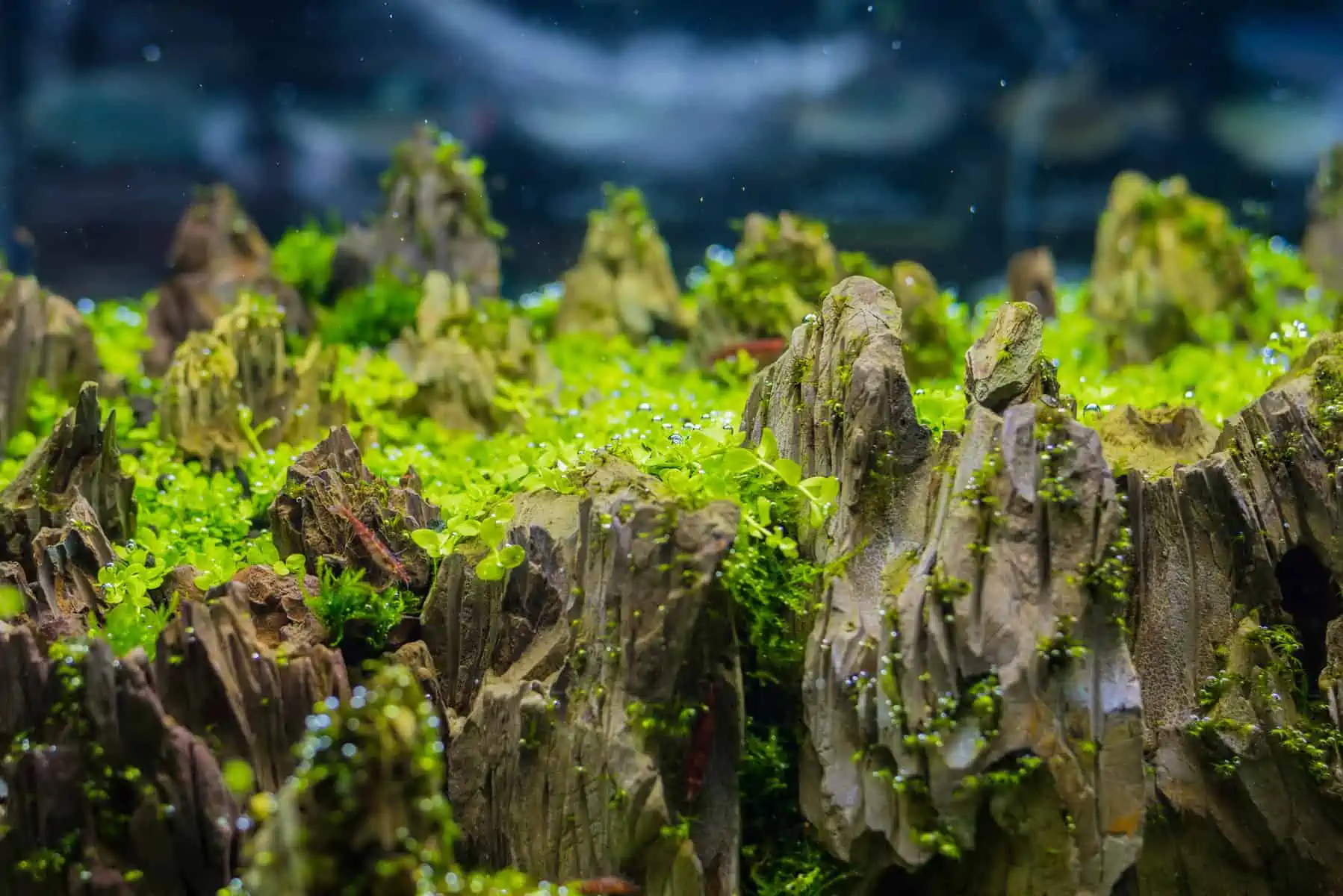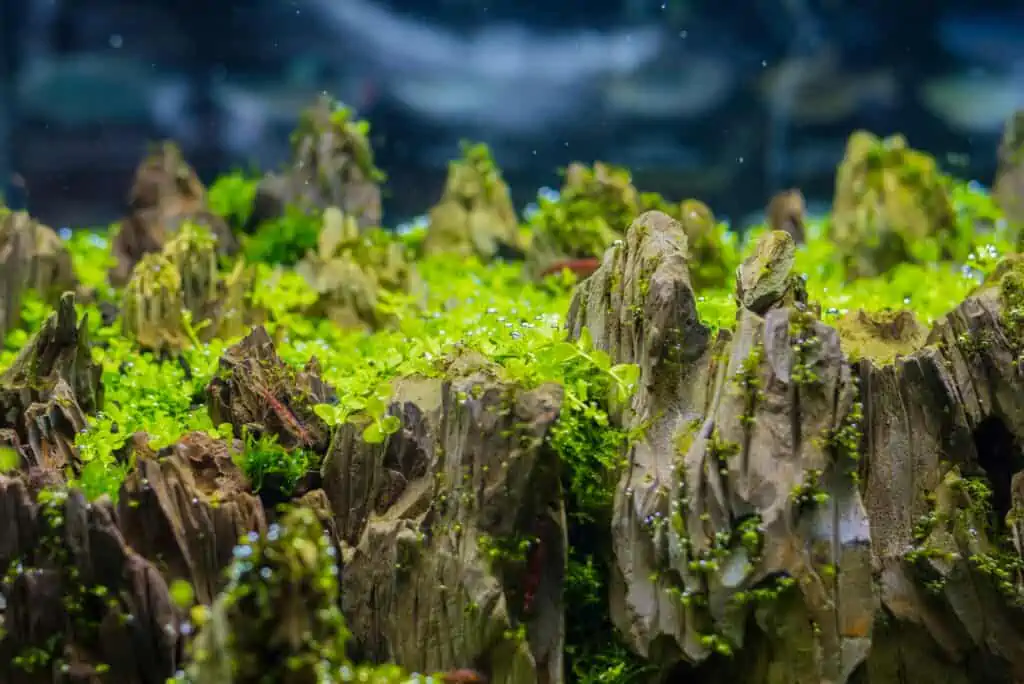Natural stone makes a beautiful addition to any aquascape. However, not all kinds of stones are suitable for your fish tank, and some rocks can dramatically affect the water quality.
Seiryu stone is incredibly popular as an aquascaping material and is used extensively in hardscape and planted setups.
So, what is Seiryu stone? Will this kind of rock affect your aquarium water pH? And is Seiryu stone safe for betta tanks?
Read this guide to learn everything you need to know about Seiryu stone and how to use it in your fish tank.
What Is Seiryu Stone?
Seiryu stone is named for the Chinese Azure Dragon, a mythical creature with brilliant blue scales. In the West, the Seiryu stone is sometimes called Yin, Dragon, and Blue Dragon stone.
The stone has a striking blueish tone, highlighted with gray and white veins of calcite that add focal points in an aquascape. The stone’s jagged grain sees this rock frequently used to create the effect of mountain ranges and cliffs as a spectacular backdrop to the vivid greens of aquatic plants or the vibrant colors of corals.
The bright colors of tropical and marine fish and invertebrates really pop when displayed against this rock, especially under high-powered grow lights. However, you must be sure that the fish you want to keep can cope with the chemical changes that this rock makes to your setup.
Takashi Amano
Renowned photographer and aquarist Takashi Amano made Seiryu stone popular worldwide when he first introduced his Iwagumi and Nature (Amano) aquascaping styles.
Mistaken Identity
Nowadays, much of the Seiryu Stone for sale outside of Japan is really Ryuoh stone.
Ryuoh stone lacks the delicate blue undertones you see in genuine Seiryu stone. Instead, Ryuoh is more of a slate gray with less of a white marble effect.
Although Ryuoh stone is popular in Iwagumi and Nature Style aquascapes and makes a much less expensive alternative, it lacks the impact of Seiryu.
How Does Seiryu Affect Water Chemistry?
Whatever rock you use to decorate your fish tank, you must consider the effects the stone can have on your water chemistry.
Many kinds of stones contain acids, carbonates, and various other elements that can cause minor or massive shifts in the water chemistry in your tank. Often, using the wrong kind of stone can cause dramatic changes in the water parameters that can make your livestock sick or even kill them.
General Rules
There are so many different rocks to choose from in your local fish store that it’s almost impossible to know the precise chemical composition of every single one. However, you can use a few general rules of thumb to determine the rock’s effect on your aquarium water parameters.
- Igneous rocks, such as granite, are generally inert and have little effect on water chemistry.
- Sedimentary and metamorphic rocks, such as marble and limestone, can impact water chemistry.
Seiryu stones are metamorphic rocks, and as such, they can dramatically affect the water pH.
Will Seiryu Stone Affect pH?
Seiryu stone contains calcium carbonate that affects the Calcium/Magnesium concentration or GH and carbonate concentration or KH of the water.
So, using this rock will cause pH levels and water hardness to increase. Although neutral water with atmospheric CO2 (a weak acid) will gradually increase pH, most fish tanks’ various tannins and other molecular content will accelerate the leaching of calcium carbonate from the Seiryu stone.
Rift Lake cichlids or livebearers prefer hard water, so the effects of using Seiryu stones are a bonus. However, if you have fish that don’t thrive in alkaline, hard water, you’ll need to take steps to mitigate the effect of Seiryu stones on your aquarium fish.
Carry Out Water Changes
As carbonate and calcium levels will continue to rise regardless, carrying out water changes is the easiest way to manage the situation. However, as long as there are no significant factors that would cause acidity in your fish tank, the pH should remain relatively stable.
Routine weekly partial water changes should be all that is necessary to mitigate the alkaline shift without negatively affecting your plants and fish.
However, if your water changes are more infrequent, the drastic shift in water hardness will be more problematic for your livestock.
Acid Buffers
Acid buffers are another highly effective method of counteracting the alkaline effects of Seiryu stones. Use Alder cones, Indian Almond leaves, an acidic substrate, or peat moss.
Since they are made from decomposed leaf mulch, peat moss and aquasoil are rich in humic acid. Unfortunately, adding acids to the water can accelerate the release of other alkaline agents in the rocks. However, that can be removed from the aquarium during your water changes.
Carbon dioxide (CO2) is generally added to a planted aquarium to encourage and boost lush plant growth. CO2 is also an acid when dissolved in water and helps return the pH to the neutral range.
How To Test Seiryu Stone for Alkalinity
If you’re unsure how rocks in aquascaping will affect your water chemistry, we recommend using a soak or acid test before introducing the stone to your setup.
Acid Test
Acid tests use concentrated vinegar, chemistry kit acids, or muriatic acid and pH buffer mixed together to create an acid solution.
Start by cleaning a section of the rock, and then dry it thoroughly. Add a few drops of the acid to the cleaned stone and watch to see if it begins fizzing. If the rock you’re testing has white marbling or other areas with a different composition, be sure to place drops of your solution on those areas, too.
Soak Test
The second method of testing your rock is known as the soaking technique.
Soak the stones in a bucket containing RO (reverse osmosis) or distilled water for a week. After that time, test the water to gauge what effect the rocks have had on alkalinity or acidity.
Aquarium Water Testing Kits
Although you can use individual water testing kits to test the water for ammonia, hardness, and pH, you can also use master test kits. Master test kits test every parameter you need and are less expensive than buying individual test kits.
Tips for Aquascaping With Seiryu Stone

Although most styles of aquascaping look good with Seiryu stone, most experienced aquarists tend to follow the guiding principles of Iwagumi Aquascaping when using Seiryu stone. Those principles place the emphasis firmly on using hardscape elements over any other style.
Three primary rock formations form the foundation of an Iwagumi Aquascape:
- Oyaishi, the keystone rock
- Soeishi, the secondary rocks
- Fujisaki, the tertiary rocks that are scattered randomly across the substrate to produce a natural, attractive effect
The Oyaishi keystone is the largest rock used in this style of aquascaping. The keystone is generally positioned slightly off-center in a nod to the more natural look rather than the formal attitude of traditional garden designs.
The Soeishi stone can be placed opposite the Oyaishi or close by in an intentionally imbalanced composition.
Minimalist Aquarium Decoration
Iwagumi Aquascaping uses minimalist techniques that allow the distinctive marbling and natural aesthetic of Seiryu stone to be the stars of the show without the distraction of other decorative aquarium rocks and excessive planting.
For example, Jungle, Nature, and Dutch aquascapes can detract and distract from the outstanding beauty of high-quality Seiryu.
You can use a light or dark substrate to show off the white marbling of Seiryu stone. However, we think that black or even brown substrate makes the white marbling of the rock really shine through, whereas pale or white gravel or sand makes the entire stone stand out.
Your choice of substrate color is entirely a matter of personal preference and the colors of the fish you want to display.
Where Can I Buy Seiryu Stone?
Unfortunately, most regular pet and fish stores don’t stock Seiryu stone.
You can buy this stone from online aquarium aquascape decor specialists, but these outlets cater to the high-end, specialist aquascaping community, and you’ll find their Seiryu stones priced accordingly.
The main downside of buying aquarium rock decor items online is that you don’t get to choose the pieces yourself. However, online retail stores are convenient and are generally the only outlets that carry Seiryu Stone.
FAQs
In this section of our guide to Seiryu stone, we answer some of the most frequently asked questions about this popular rock.
Where Is Seiryu Stone From?
Seiryu stone comes from Japan.
How Can I Break Seiryu Stone?
It’s quite easy to break Seiryu stone into smaller pieces.
All you need to do is to cover the stone with a towel and bash it firmly with a hammer. However, that will most likely result in a random pile of scraps of rock that might not necessarily be aesthetically pleasing. So, we recommend using a hammer and chisel to remove pieces of stone in a more controlled manner.
Since these types of rocks tend to splinter quite easily, we advise wearing safety goggles when splitting or breaking them.
What Is Seiryu Stone Made Of?
Seiryu stone is a sedimentary rock primarily made up of carbonated limestone with bright streaks of white calcite running through its layers like veins. The rock is typically jagged and ridged, making it ideal for creating a dramatic hardscape in fish tanks.
How Do You Clean Seiryu Stone?
Before adding rocks to your aquarium, it’s vital to wash them first to remove debris and dust that would otherwise get into your tank water.
Many aquarists like to boil the Seiryu stone for at least 30 minutes to kill off any harmful microorganisms or bacteria lurking on the stones. However, if you prefer, you can simply soak the stones in a solution of one part bleach to ten parts water (1:10) for a couple of hours.
Before adding the rocks to your fish tank, rinse them thoroughly in water to remove any residual bleach solution.
Is Seiryu Stone Safe for Betta Fish?
Japanese Seiryu stone makes the perfect Oriental backdrop for a betta fish tank, especially when it’s teamed with suitable planting.
But is Seiryu stone suitable for use in a betta tank?
Seiryu stone contains calcium carbonate, which can dramatically affect the aquarium water. Specifically, this rock causes the pH levels and water hardness to increase. Basically, using Seiryu stone generally results in alkaline, hard water.
Betta fish prefer water with a pH between 6.5 and 7.0, with 7.0 being neutral. So, if the pH level rises beyond that, the water could become too alkaline for your betta. Ideally, the water should be soft and acidic. So, any rocks or substrate that cause the GH, KH, and pH to increase should be avoided.
In addition, most betta fish chosen as ornamental pets have long, flowing fins. One of the primary characteristics of Seiryu stone is its jagged edges, which could present a hazard to the betta’s trailing finnage.
Final Thoughts
Did you find our guide to Seiryu stone helpful? If you did, please remember to share the article!
Seiryu stone is a beautiful Japanese rock that is sought after by aquascape enthusiasts worldwide. These rocks are highly decorative and popular, and their price reflects that.
However, the Seiryu stone’s chemical composition can dramatically change your aquarium water parameters, which could affect the health of your fish.
If you introduce any type of rocks to your fish tank, you must test the water each week or so to ensure that the pH, GH, and KH are still suitable for your fish and make any adjustments necessary to rebalance the parameters.
Do you have Seiryu stone in your aquarium? What kind of fish do you keep? Tell us your story in the comments box below.


